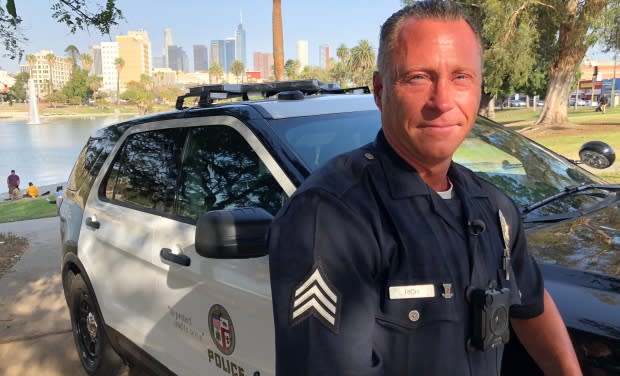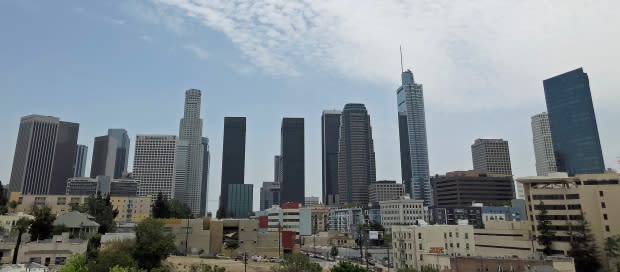'Predictive policing': Law enforcement revolution or just new spin on old biases? Depends who you ask
In a city with a long history of law-enforcement friction, activists and the Los Angeles Police Department are squaring off again. The latest crime-fighting controversy isn't over issues like police brutality, corruption or gangs — it's all about data.
And the ways police are using it.
Activists at a public meeting with the Los Angeles Police Commission this summer held up signs reading: "Data Driven Evidence Based Policing = Pseudoscience," and "Crime Data is Racist." It's an example of how the community has been put on edge by the LAPD's use of an elaborate data collection centre, a shadowy data analysis firm called Palantir, and predictive algorithms to try to get a jump on crime.
"We're trying to get better about where to put scarce police resources to prevent crime from happening in the first place," says Deputy Chief Sean Malinowski, who was at the meeting to defend the use of data analytics to help guide policing activity.
"Implicit bias is something the LAPD has been struggling with," counters Jamie Garcia, of the Stop LAPD Spying Coalition, a tiny community group which monitors the LAPD.
"The data they're using is the data that's collected by law enforcement," Garcia adds, saying that as a result it's inherently flawed.

Los Angeles isn't the only place where concerns are flaring over how citizens' data is collected and used by law-enforcement authorities.
Police forces across the U.S. are increasingly adopting the same approach as the LAPD: employing sophisticated algorithms to predict crime in the hope they can prevent it. Chicago, New York City and Philadelphia use similar predictive programs and face similar questions from the communities they are policing, and even legal challenges over where the information is coming from and how police are using it.
Canadian police forces are very aware of what their U.S. counterparts are doing, but they are wary of jumping in with both feet due to concerns over civil liberties issues.
Thinking inside the box
Sergeant Dave Rich checks a printout of a map of Los Angeles that has problem areas marked in red boxes. He tucks the paper under his car's visor, throws his "black and white" into gear and pulls out of the Los Angeles Police Department's Rampart Division headquarters, heading for one of the red boxes on Sunset Boulevard.
Instead of an old-fashioned LAPD crime analyst creating that map and the red boxes, it's a computer algorithm which has identified the problem areas on the map — or predicted future problem areas, to be precise.

The sophisticated program is called PredPol, short for predictive policing, and it's used to varying degrees by 50 police forces across the United States. The genesis of the program came from a collaboration between LAPD deputy chief Sean Malinowski and Canadian Jeff Brantingham, an anthropology professor at UCLA.
"Driving through areas that have been identified as problematic, sometimes you just get flagged down," Rich says. "You can roll right into a robbery in progress."
The LAPD's PredPol software program produces updated, predictive property crime maps at 1:30 a.m. each day, which are handed out to officers on the morning shift. The maps are updated later in the day for subsequent shifts.
PredPol uses several years of crime reports to predict where police patrols should concentrate their efforts.

"This area across the street from us right here has been identified as a problem," Rich says, driving through the 1300 block of Wilshire Blvd near the downtown core's MacArthur Park.
"The officers are encouraged to spend their available time here doing proactive policing, as well as just being a visible deterrent to crime," says Rich, as he drives into the area indicated by one of the map's boxes. The cruiser's movements are monitored remotely.
"It will also be documented that we passed through this area for X-amount of time, and that will also get uploaded into the system. So they [the LAPD] can identify specifically how much time was actually spent within this particular box."
Sarah Brayne, a Canadian sociologist, spent two years inside the LAPD studying its use of predictive policing. She says the LAPD has been using predictive policing since 2012, and crunching data on a wide range of activities — from "where to allocate your resources, where to put your cars, where to put your personnel, to helping investigators solve a crime. And even for some risk management, like tracking police themselves, for performance reviews and different accountability reasons."

Still, data-driven systems are something relatively new to LAPD culture, Captain Jeff Nolte says.
"Algorithms don't sound that sexy, right?" says Nolte. "LAPD has a culture of some of the movies you see — of great detectives using intuition to solve crime and do all these things that people think are sexy. Then here comes PredPol and other data-driven systems."
It has been a challenge to get all the officers to buy in.
... Very few people can define or explain what an algorithm is. They say things like, 'Oh, it's just witchcraft.' - Sarah Brayne, sociologist
"On a lot of my ride-alongs I would ask the cops to define an algorithm, and very few people can define or explain what an algorithm is," Brayne says. "So they say things like, 'Oh, it's just witchcraft.'"
But does it work?
"It's too early to say if it does lead to more effective policing," says Brayne.
"But I think it has the potential to, yes, because there is the efficiency aspect of it. From where you are allocating resources to where crime is occurring, as opposed to your biased perceptions of where it is occurring."
Pinpointing suspects
At Rampart headquarters, Captain Nolte is one of those who has bought in. There are still no hard stats available, but anecdotally he says that whenever he can deploy officers to cover off the boxes outlined on the daily maps, property crime in the community is reduced.
Nolte stresses that PredPol doesn't pump out information about individual suspects, it's just a location-based type of predictive policing.
"It's focusing on a geographic area. PredPol has no information on suspects."
He adds that the system, "is no different than the police radios telling us where to go," emphasizing that, "It's not telling us what to do."

But PredPol is just one of the police systems that community watchdogs like Garcia are concerned about.
The Rampart division of the LAPD uses another program to pinpoint individuals who are at risk of committing crimes in the future. This is known as person-based predictive policing.
Critics call it profiling.
The program is called Los Angeles Strategic Extraction and Restoration (LASER). At the moment it generates a list of approximately 20 "chronic offenders" that is updated monthly.
LAPD documents show how LASER gives people specific scores, which increase with each police encounter.
You get five points if you are a gang member. Five points if you are on parole or probation. Five point for arrests with a handgun. And one point for every "quality" police contact in the past two years, which includes what the LAPD calls "Field Interviews."
In Canada, field interviews are called "carding," referring to the cards police use to record information about the people they have stopped — even when there are no grounds to think they've committed an offence.
Data on individuals is written down by hand and later entered into the LAPD database. It includes "descent," which refers to race.
On the chronic offender bulletin there are names, addresses, scores ranging from six to 28, dates of birth and gang affiliations (Crazy Riders, Wanderers, 18th Street, and so on).
The police try to track down the people on the bulletin and hand-deliver an "At Risk Behaviour" letter to each one — if they can find them.
The letter is signed by the Chief of Police and Captain Nolte. It says the recipient has a "propensity to engage in at-risk behaviour" and that the purpose of the letter "is to encourage you to refrain from this behaviour in the future."
"Law enforcement respects you and and knows you have the ability to make choices. We want you to make the choices that are right, legal and moral," it adds.
The letter encourages the recipients to reach out to a list of local service providers, such as Home Boy, which offers "hope, training and support to formerly gang-involved and previously incarcerated men and women" in Los Angeles.
Officers are given instructions to contact the offenders on the list every month "to check their status" and to remind them to use the community services. They are also encouraged to door-knock on adjacent residences to "spark interest and gather info."
'Pretty frightening'
Some community groups are concerned about the kind of data going into the algorithms, and how it's gathered. Jamie Garcia at the Stop LAPD Spying Coalition calls predictive analytics "pretty frightening."
"It's basically policing as it has always been," she said. "It's trying to convince communities that by using data, by driving algorithms and risk assessments with data, that somehow policing is becoming more effective, efficient and fair. I think that is really problematic, because it is trying to mask policing how it has always been, which is impacting the black and brown communities."
Nolte counters that, saying the suspect-pool only reflects the community.
"With PredPol or LASER, these are all data that has been reported by the victims and witnesses. It's nothing we are creating and pushing out. But I do understand that how we use it and how we execute it is critical."

Sarah Brayne sees police data collection only growing over the next five to 10 years, while concerns mount and the law protecting citizens' rights and privacy scrambles to catch up.
"All of the new surveillance technologies — the tools that can collect data on all of us, not just people with police contact — that technology is moving so much faster than the laws and regulations. And as such, it is part of this legal and regulatory wild west," Brayne says.
For a city like Los Angeles, at the forefront of using data to fight crime, it likely means more situations such as the public Police Commission meeting this summer, where activists are pitted against police.
At that meeting, Michel Moore, the new Los Angeles police chief, acknowledged that the data was imperfect and supported an inspector general review. But in the meantime, systems like PredPol and LASER are in daily use.
"We've seen that here in Los Angeles, that when that trust is violated you see civil unrest," Nolte says.
"We have learned from our past. You know, we're not perfect, but we're definitely a lot better than we were."
- With files from Kim Brunhuber and Matthew Braga

